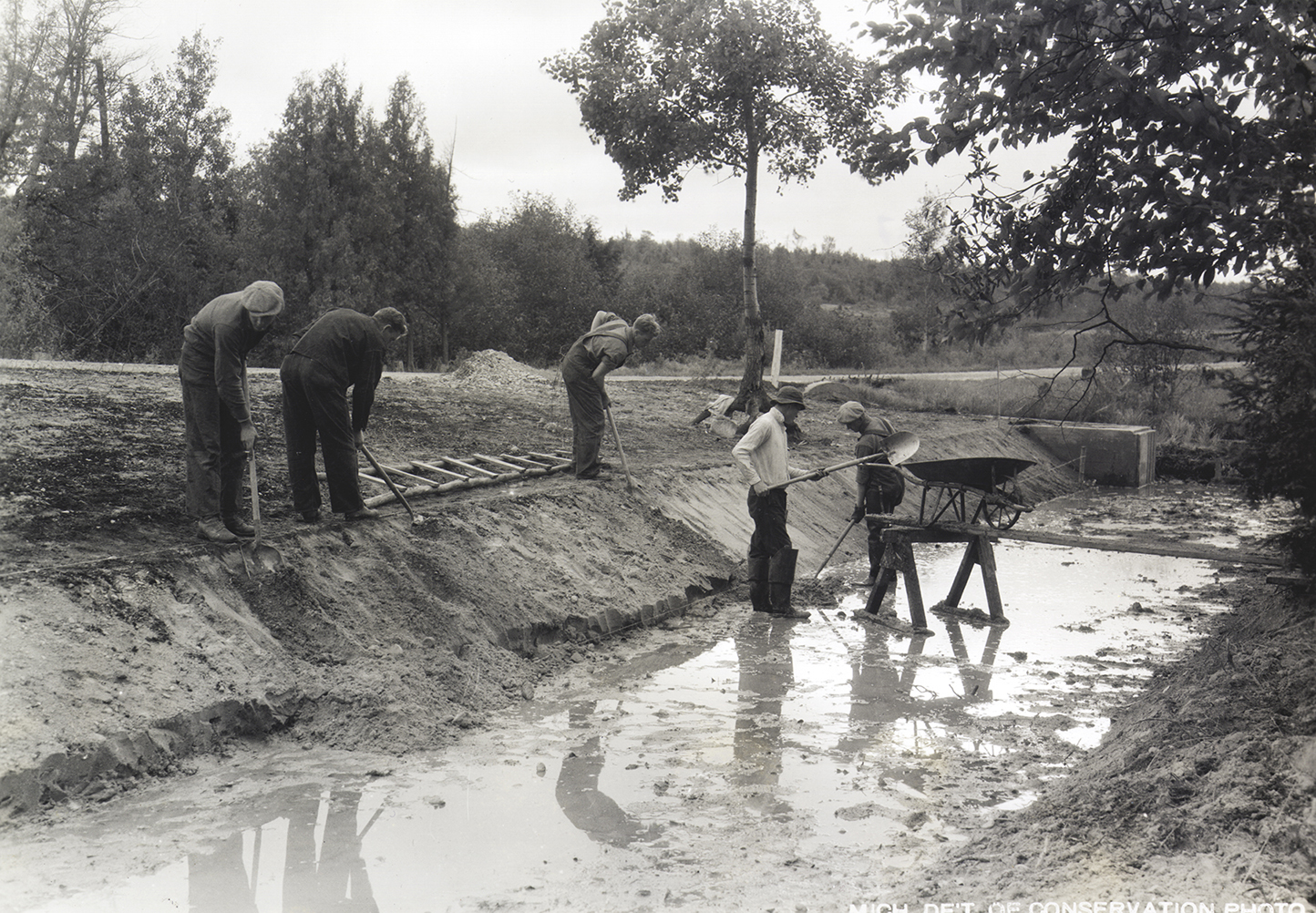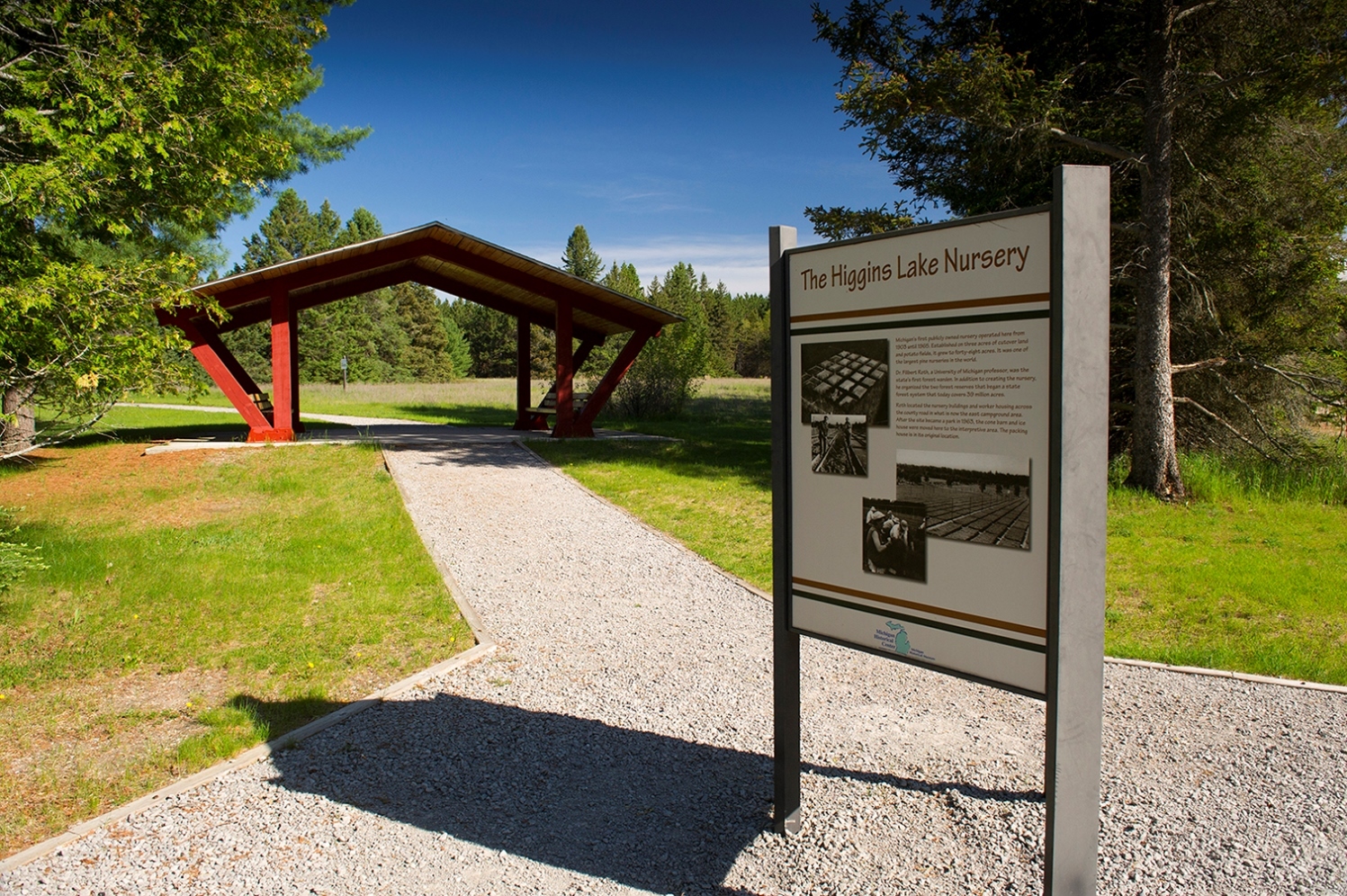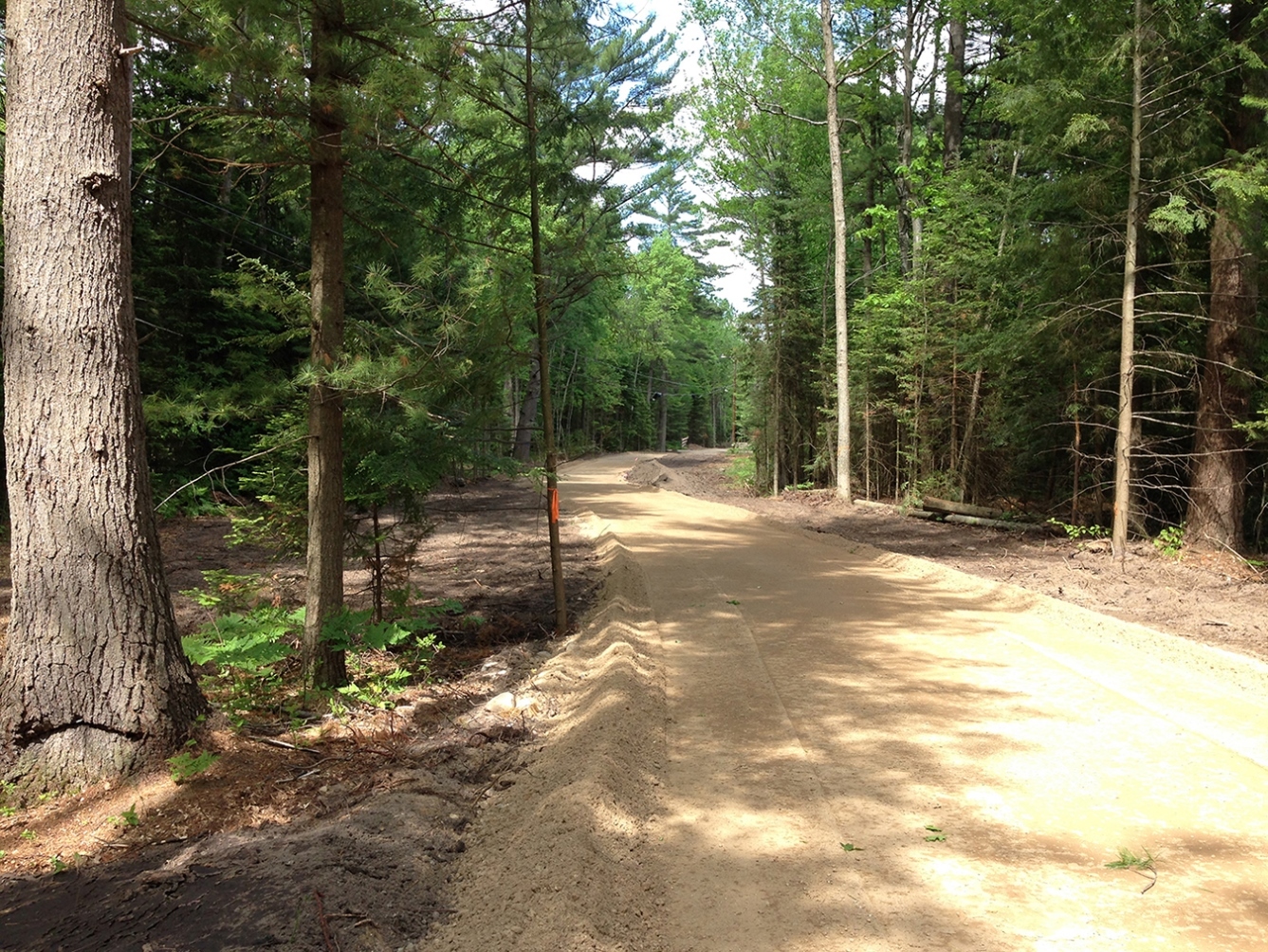Celebrating Michigan’s forest conservation roots
DNR makes plans to commemorate 115th anniversary of state’s first tree nursery, 85th anniversary of the Civilian Conservation Corps
By TOBI VOIGT
Michigan Department of Natural Resources
In 1903, a team of workers under the direction of newly appointed State Forest Warden Filibert Roth pondered the stump-ridden, sandy terrain on the north shore of Higgins Lake, south of Grayling in Michigan’s northern Lower Peninsula.
 Once a thriving old-growth forest, the nearly barren landscape had suffered from aggressive lumbering and a series of fires in the late 19th century. The workers’ job was to replant the forest. Once a thriving old-growth forest, the nearly barren landscape had suffered from aggressive lumbering and a series of fires in the late 19th century. The workers’ job was to replant the forest.
The Michigan Legislature had just established the Michigan Forestry Commission and given it authority to create the state’s first tree nursery and forest reserve.
Within a year, Roth and his workers had planted 43 pounds of seed, representing 12 different pine species.
It was an experimental venture.
“Considerable damage was done (to the seed beds) by birds but far more by the ordinary striped gopher which proved quite a pest, and in spite of a shot gun, completely destroyed all seeds of nut and sugar pine and much of white pine,” Roth wrote in his first official report.
Nonetheless, more than 600,000 seedlings were thriving in 1904 and, by 1906, Roth’s team had successfully cultivated 27 species of trees.
Twenty years later, the nursery was shipping 22 million seedlings across the state and nation every year, and the new forest was growing.
Local residents collected pine cones and sold them to the nursery. In the cone barn, the cones were heat-dried to release their seeds. The seeds were planted in irrigated beds and tended for three years before they were ready for shipment to new barren areas.
The seedlings were planted in straight rows that remain visible on the landscape today.
As the seedlings grew, scientists, such as Michigan State University Professor W. J. Beal, worked to learn more about what kinds of trees grew best in Michigan soils and how to best cultivate them.
In a nearby experimental stand, Beal thinned the trees to see if those left standing would grow larger faster – they did.
Roosevelt’s Tree Army
Reforestation was hard, manual labor in those days, and in 1933, a new labor force arrived on the scene – the Civilian Conservation Corps.
A New Deal program created during the Great Depression by President Franklin D. Roosevelt, the CCC employed young men in many public-works projects, including “the prevention of forest fires, floods, soil erosion, plant, pest and disease control.”
Soon after taking office, Roosevelt wanted to move quickly to try to restore the nation’s economy and the spirit of the country, both of which had been crushed by the Great Depression. He also sought to rejuvenate America’s natural resources.
The legislation creating the Civilian Conservation Corps was approved by Congress in just four days. Roosevelt signed the bill March 31; the first camp – Camp Roosevelt – opened in Virginia April 3.
By July 1, the CCC initiative had put 274,375 young men, aged 17 to 25, to work in more than 1,300 camps across the nation, improving state and national forests. Eventually, there would be 2,650 camps scattered all over the country.
In Michigan, thousands of recruits planted trees and fought forest fires across the northern Lower Peninsula and Upper Peninsula. In 1933, those stationed at the Higgins Lake CCC Camp began working at the tree nursery, which was not far from the camp.
From firefighting to tree planting to building roads, bridges and parks, “Roosevelt’s Tree Army” was a dynamic force upon the countryside. By December 1933, the corps was involved in 60 different lines of activity.
“This readily available and properly distributed volume of labor, made possible by the existence of Emergency Conservation Work camps, has proven to be of inestimable value,” a Michigan Conservation Department report said. “Particularly during the bad fire season in 1933 at which time hundreds of fires threatened to destroy millions of acres of valuable second growth timber and game cover on both state and privately-owned lands.”
 During 1933, about 10 million trees, chiefly pine and spruce, were planted on 17,656 acres of cutover state land in Michigan, with that figure expected to double the following year. During 1933, about 10 million trees, chiefly pine and spruce, were planted on 17,656 acres of cutover state land in Michigan, with that figure expected to double the following year.
State officials said enough miles of truck trails were built during the initial year or so of the CCC program in Michigan to reach from Lansing to Jacksonville, Florida, and back.
In 2013, the 80th anniversary of the CCC, Marquette author and CCC researcher Larry Chabot told The Mining Journal the boys enrolled learned self-discipline, and how to work and live in groups and gained confidence with increasing skills and training.
“Parents were often stunned when the boys came home. One woman told me that when her brother came home from camp, they didn't recognize him,” Chabot said. “Over and over, the CCC boys were heard to say, ‘This was the best time of my life’ or ‘This was the best thing that ever happened to me.’”
Chabot said crews developed pride in their work and their camp and made life-long friends as they grew in self-confidence and work habits. They also earned vital income for their families.
By 1942, when the CCC program ended, Michigan workers had planted 484 million trees, more than twice the amount of any other state.
In the early 1960s, with initial reforestation largely completed and because of changing forestry methods, the Higgins Lake Nursery ceased operation.
Today, the land on which the original Higgins Lake Nursery stood is within North Higgins Lake State Park.
For many years alumni of the CCC in Michigan held an annual reunion there, and in 1985, they led efforts to create the Civilian Conservation Corps Museum at the tree nursery site.
The museum, built in the style of a CCC barracks, opened in 1986. The importance of the CCC experience in the lives of the alumni was evident in their photographs and mementoes, saved for decades and donated to the Michigan History Museum and the Archives of Michigan.
DNR Parks and Recreation Division Chief Ron Olson said remnants of Michigan Civilian Conservation Corps continue to work on state park stewardship projects.
“We also have urban-focused summer youth employment programs that employ 16- to 19-year-olds from Detroit, Flint, Pontiac and Saginaw to provide mentored work in the out of doors that enhances their communities and state parks,” Olson said.
Commemoration
To mark the 115th anniversary of the tree nursery and the 85th anniversary of the CCC, the Michigan History Center and other divisions within the Michigan Department of Natural Resources are working together to better tell the story of natural resources conservation in this part of the state.
These efforts began last summer, when the DNR completed work on a 2-mile segment of Michigan’s Iron Belle Trail at North Higgins Lake State Park.
Plans are in place to connect the trail to an existing fitness trail on the CCC Museum grounds this summer, and eventually to extend it north. Named the “Cradle of Forestry,” the trail will feature new and enhanced interpretive signs that share the area’s forest history with visitors.
 Hillary Pine, northern Lower Peninsula historian with the Michigan History Center, has been researching the area’s history for the development of the new trail signs. Hillary Pine, northern Lower Peninsula historian with the Michigan History Center, has been researching the area’s history for the development of the new trail signs.
“Sharing the successes of Michigan’s early forest conservation movement along a trail that benefited directly from those efforts is quite powerful,” Pine said. “We’ve been working with the DNR’s Forest Resources Division to bring the story up to the present day. It is really inspiring to see the connection of this place to Michigan’s more than 4 million acres of forest land (managed by the DNR) today.”
Pine also oversees the Civilian Conservation Corps Museum, where improvement efforts began last fall.
In September, nearly 125 volunteers from Grand Valley State University’s Michigan Cares for Tourism program worked with DNR staff to repaint the historic nursery buildings and replace the tarpaper on the barracks building.
Michigan History Center staff is currently developing new signage for the museum’s nursery buildings, with the goal of sharing more of the site’s 115-year history. The new signs will be installed in time for the museum’s seasonal opening on May 5.
Long-range plans for the museum and nursery site include converting the 1923 Packing House, which is now empty, into an interpretive center.
This summer, a museum guide will be on site to present programming and historical information to visitors.
For CCC Museum visitor information, go to www.michigan.gov/cccmuseum. A programming schedule will be available in late spring.
From the ashes of devastating fires and the cutover pine days, Michigan’s seeds of a sustained regenerative forestry campaign were sown in the northern Lower Peninsula at North Higgins Lake, first with the early efforts of the Michigan Forestry Commission and a generation later with the help of Roosevelt’s Tree Army.
Today, Michigan has 20 million acres of forest lands, with the state ranking first in the nation in pine acreage, third in hardwood. Almost 6 million acres of Michigan forests are certified as sustainably managed.
The DNR continues to plant over 5 million pine seedlings each year.
“Michigan’s forests, the diverse forest products industry, and the natural resources that sustain it are among the best in the nation,” said DNR Forest Resources Division Chief Debbie Begalle. “In addition to supplying the wood for the products people rely on, Michigan’s forest land provides important wildlife habitat, recreational opportunities, and plays a critical role in supporting the state’s regional and rural economic health for thousands of residents.”
Check out previous Showcasing the DNR stories and subscribe to upcoming articles at www.michigan.gov/dnrstories.
/Note to editors: Contact: Tobi Voigt, 517-241-1442 or John Pepin, 906-226-1352. Accompanying photos are available below for download. Suggested captions follow.
AuTrain: Hilly terrain and foundation blocks are remnants from Civilian Conservation Corps Camp AuTrain in Alger County. (John Pepin photo)
Barracks: Exhibits at the Civilian Conservation Corps Museum, like this interior view of a barracks building, give visitors a glimpse of how workers lived at a CCC camp.
Crew: Civilian Conservation Corps crews worked on countless projects across Michigan and the nation during the 1930s. (Archives of Michigan photo)
Life: A display showcases some souvenirs from Civilian Conservation Corps camp life.
Museum: The North Higgins Lake State Park history area includes the Civilian Conservation Corps Museum and several original buildings that were used by workers at the Higgins Lake Nursery.
Nursery: The former site of the Higgins Lake Nursery.
Raco: A view of Camp Raco in Chippewa County, the first Civilian Conservation Corps camp established in the Upper Peninsula.
Statue: A statue pays tribute to the work of the Civilian Conservation Corps at North Higgins Lake State Park in Crawford County.
Trail: In summer 2017, a 2-mile segment of Michigan’s Iron Belle Trail at North Higgins Lake State Park in Crawford County was completed. Efforts are now underway to expand the trail through the historic Civilian Conservation Corps Museum site./
The Michigan Department of Natural Resources is committed to the conservation, protection, management, use and enjoyment of the state’s natural and cultural resources for current and future generations. For more information, go to www.michigan.gov/dnr.
|

 Once a thriving old-growth forest, the nearly barren landscape had suffered from aggressive lumbering and a series of fires in the late 19th century. The workers’ job was to replant the forest.
Once a thriving old-growth forest, the nearly barren landscape had suffered from aggressive lumbering and a series of fires in the late 19th century. The workers’ job was to replant the forest.
 During 1933, about 10 million trees, chiefly pine and spruce, were planted on 17,656 acres of cutover state land in Michigan, with that figure expected to double the following year.
During 1933, about 10 million trees, chiefly pine and spruce, were planted on 17,656 acres of cutover state land in Michigan, with that figure expected to double the following year.
 Hillary Pine, northern Lower Peninsula historian with the Michigan History Center, has been researching the area’s history for the development of the new trail signs.
Hillary Pine, northern Lower Peninsula historian with the Michigan History Center, has been researching the area’s history for the development of the new trail signs.




